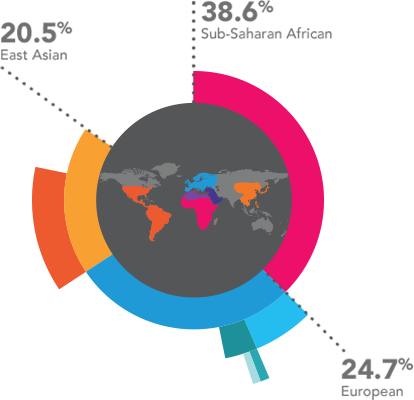More than a decade ago, genome sequencing was still far from the daily life of ordinary people, and the cost of sequencing was as high as about 100 million US dollars per genome. With the advent of the $1,000 era of genome sequencing, personal DNA testing services have also begun to enter the homes of people in developed countries. 23andMe is one of the most successful consumer genetic testing companies. 1.2 million complete data 23andMe was founded in 2006. Founder Anne Wojcicki is the sister of Susan Wojcicki, CEO of YouTube, the online video company of Google. It is also the ex-wife of Google co-founder and president of Alps, Sergey Brin. The author has compiled an article about the current status of 23andMe, to show you the research field and profit model of the genetic testing company. Today, consumers only need to spend more than a hundred dollars to put their saliva in the genetic testing kit and mail it to 23andMe, you can get an online DNA report after dozens of days to know your ancestral origin and bloodline mixture. Situation; 23andMe can also use its database to help users find family close relatives in the database. In addition, users can choose to use DNA data for genetic research to find treatments for the disease. Since its creation 10 years ago, 23andMe has continued to attract users to improve the database through low prices and cool concepts, and this growing database is at the heart of its profitability. 23andMe currently has 1.2 million complete data, including genomes and user data that have been sequenced, which can be found on the phone anytime, anywhere. Big data has been applied to clinical research Today, with the development of precision medicine , 23andMe uses big data to find the relationship between specific genetic traits and different diseases. The analysis results and raw data are what many pharmaceutical companies and research institutions are eager for. It is also through its vast database that the company's consumer DNA database has begun to pay off. But 23andMe said that their data and results can only barely keep up with the needs of researchers. At the same time, they also face a dilemma. As a provider of DNA data, users believe that they should also take a share of the company's profits. Researchers sponsored by Pfizer and the Massachusetts General Hospital said they had identified several genetic markers associated with depression in August this year. The study, which took decades of data and used more than 120,000 people, is the largest of its kind. Indeed, many diseases are related to genes, which is also confirmed by medicine. For example, a paper published in February this year concluded that genetics determines whether a person is an “early bird†or a “night owlâ€; in April, another study explored how to defend against Mendelian childhood diseases such as cystic fibers. And so on. The data used in the above studies were all from 23andMe, which has a Google background. Perhaps the most impressive thing about the company before this was its aggressive battle with the US FDA on the regulation of consumer genetics in 2013, although in the end 23andMe still had to compromise the FDA and stop providing genetic diseases to the general public. Probability reports, but in the next three years, by quietly expanding the business, the company's database has collected more than 1 million users of DNA. Anyone applying to use the company's $199 test kit will receive a request to participate in the study. If the user agrees, their health data will be added to a separate database. With the continuous development of 23andMe business, 80% of users have agreed to participate in the survey, and the huge medical database accumulated has become the gold mine that all researchers have dreamed of. 23andMe has hired nearly 70 scholars to work with the company's researchers, and many of the research results have been published in top scientific journals. Researchers can obtain genetic data, “phenotypic†characteristics or traits, and feedback through online surveys, which are a huge treasure for researchers. Bacterial Culture,Laboratory Sterile Petri Dish,Disposable Sterile Petri Dish,Disposable Plastic Petri Dish Jiangsu HXRT MD Co.,Ltd , https://www.jshxrtmed.com
23andMe company website population ratio